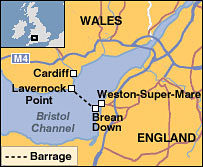 For more than 150 years, engineers have toyed with the idea of constructing a dam across the width of the Bristol Channel, in Western England.
For more than 150 years, engineers have toyed with the idea of constructing a dam across the width of the Bristol Channel, in Western England.
However, the scheme took a large step towards reality yesterday, when John Hutton, the Secretary of State for Business, announced a multimillion- pound feasibility study into the construction of a barrage linking Somerset to South Wales, championing it as a “truly visionary” project which could put Britain firmly on the road towards cleaner, renewable energy.
The Government’s glowing endorsement has revived the thorny dilemma long agonised over by green and conservation groups: Is it worth sacrificing some of the mud-flats along the river, home to thousands of wading birds, in order to generate vast amounts green energy?
Mr Hutton made clear where his loyalties lay, lavishing praise on the proposals and calling for a “step change” in the use of energy generated by the force of the tides, rivers and the wind. The Government shows every sign of wanting to approve the scheme as it alone could provide 5 per cent of Britain’s energy through renewable power by the year 2020.
The estuary contains mudflats, saltmarshes, rocky islands and food that support some 65,000 birds in winter. The Wildfowl and Wetlands Trust, which runs wetlands in the area, warned: “The construction of a huge dam across the estuary could have a massive environmental impact on this delicate ecosystem and all of the wildlife that depends upon it.”
